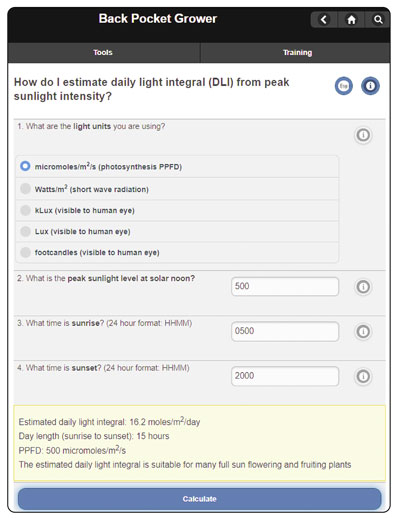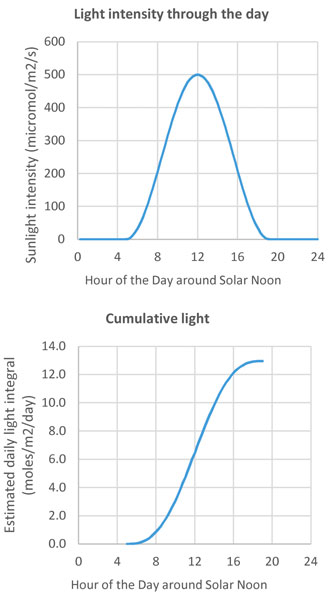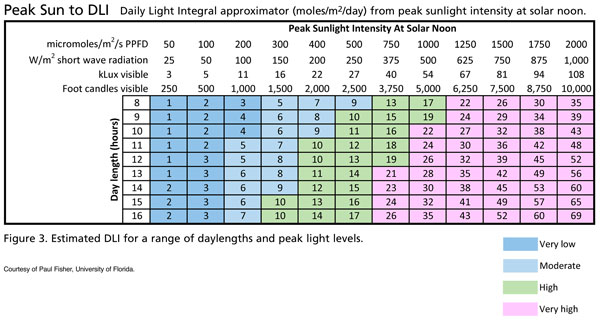8/1/2023
Peak Sun to DLI
Paul Fisher
Daily light integral (DLI) in moles/m2/day is a measure of accumulated light available for plant photosynthesis. Plants grown at an adequate DLI tend to have more branches, flowers, fruit and more compact growth compared with plants grown with low DLI. Plants grown at an excessively high DLI may suffer from heat and drought stress.
 This article describes a new and free online tool for growers to esti-mate the DLI based on light level at solar noon, and the sunrise and sunset times. You can access the tool at backpocketgrower.org under “Tools” and then select “Peak Sun to DLI” (Figure 1). The tool is in both English and Spanish. We (University of Florida) provide training about this tool and other aspects of climate control in our new online grower course on Environmental Crop Management, which begins in October 2023 (see hort.ifas.ufl.edu/training).
This article describes a new and free online tool for growers to esti-mate the DLI based on light level at solar noon, and the sunrise and sunset times. You can access the tool at backpocketgrower.org under “Tools” and then select “Peak Sun to DLI” (Figure 1). The tool is in both English and Spanish. We (University of Florida) provide training about this tool and other aspects of climate control in our new online grower course on Environmental Crop Management, which begins in October 2023 (see hort.ifas.ufl.edu/training).
Figure 1. Screen shot of the Peak Sun to DLI tool showing a daily light integral of 16.2 moles/m2/day with an example peak sunlight level of 500 micromoles/m2/s at solar noon and a 15-hour daylength.
The DLI of photosynthetically active radiation (PAR) is a major determinant of crop yield and quality for both ornamental and edible crops. If you think about a square meter of your greenhouse bench as being like a bucket and the light intensity being like rainfall, the DLI would represent how much water (i.e., photons of light for photosynthesis) the bucket would collect over the course of a day. (www.tinyurl.com/FourConceptsOfLight to check out our video about DLI to help visualize this and other light concepts.)
Targets for DLI to produce high crop quality and yield have been established by researchers for most horticultural crops. Typical targets for acceptable horticulture crop yield and quality include:
• <5 moles/m2/day is too low for most crops
• 5 to 10 moles/m2/day for propagation of young plants or production of shade plants
• >10 moles/m2/day for production of most full sun flowering plants and vegetable crops
(Go HERE to see more specific DLI targets from a fact sheet from Purdue University.)
 The most accurate way to measure DLI is to continuously monitor and add up light intensity using a sensor that measures PAR light connected to a data logger (available online from companies such as Apogee Instruments, Onset Computer Corp. or Spectrum Technologies). However, many growers lack weather stations and light sensors inside their shade areas, tunnels or greenhouses.
The most accurate way to measure DLI is to continuously monitor and add up light intensity using a sensor that measures PAR light connected to a data logger (available online from companies such as Apogee Instruments, Onset Computer Corp. or Spectrum Technologies). However, many growers lack weather stations and light sensors inside their shade areas, tunnels or greenhouses.
For our alternative approach to estimate DLI, you just need a light meter and access to the Internet. Figure 2 shows an example with a peak PAR light measurement at solar noon of 500 micromoles/m2/s and a 12-hour daylength, resulting in a DLI of 13 moles/m2/day. That DLI would be high for growing shade foliage plants, but ideal for geraniums. The DLI will increase with either a long daylength (more hours of sun) or a high peak sunlight level (a sunny day).
Figure 2. Curve showing a typical curve of light intensity through the day (top) and (bottom) the accumulation of this light over the course of a day (the DLI).
To use the tool, you need to measure light level using a light meter at solar noon. The most accurate light meter for this purpose is a “quantum light sensor” with units of micromoles/m2/s designed to measure PAR (for most applications, this is 400 to 700 nm wavelengths). If you don’t have a quantum light sensor, you could approximate with a pyranometer that measures short wave radiation (in Watts/m2, which are included in weather stations on many environmental control computers) or a visible light meter (kLux, Lux or foot candles). Our model assumes approximate conversion factors for sunlight of 1.0 micromole/m2/s = 0.5 W/m2 = 0.0538 kLux = 53.82 Lux = 5 foot candles.
Solar noon doesn’t necessarily mean 12:00 p.m. depending on your location, time zone and daylight savings time. (You can find solar noon for your latitude and longitude at gml.noaa.gov/grad/solcalc.) You can use the same website to find the “apparent sunrise” and “apparent sunset,” which are needed to calculate daylength.
Figure 3 estimates DLI for a range of daylengths and peak light levels. For example, if you had a peak sunlight level of 300 micromoles/m2/s with a daylength of 10 hours, we estimate a DLI of 6 moles/ms2/day. That would be fine for propagating cuttings, but not enough light for flowering petunia plants.
 Figure 3. Estimated DLI for a range of daylengths and peak light levels.
Figure 3. Estimated DLI for a range of daylengths and peak light levels.
The scope of this tool is only for sunlight in field conditions or protected structures with fixed or no shade (not moving shade) and without electric lighting. Calculations have been calibrated from latitudes up to 43 degrees. Locations at higher latitudes have not been tested, such as northern Canada. Most estimated DLI is within 10% of actual, but the tool is less accurate in locations that have highly changeable weather during the day (such as afternoon thunderstorms). Daily data can be averaged over one week to improve model accuracy. GT
Acknowledgements: This article was funded by our industry partners at the Floriculture Research Alliance (floriculturealliance.org), and with support from the Floriculture & Nursery Research Initiative “Resilient Plants” project.
Paul Fisher is a Professor and Extension Specialist at University of Florida IFAS Extension (pfisher@ufl.edu) and Bruce MacKay is the President of freshLearn online horticulture training solutions (freshlearn.co.nz).